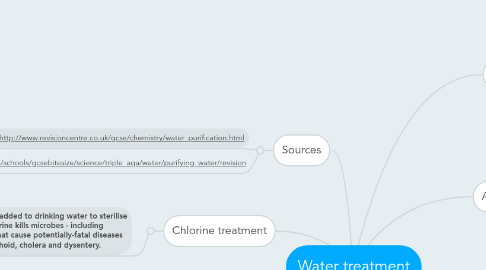Water treatment
Jonathan Adrian Wirawanにより


1. Chlorine treatment
1.1. Chlorine is added to drinking water to sterilise it. The chlorine kills microbes - including microbes that cause potentially-fatal diseases such as typhoid, cholera and dysentery.
2. Sources
2.1. http://www.revisioncentre.co.uk/gcse/chemistry/water_purification.html
2.2. http://www.bbc.co.uk/schools/gcsebitesize/science/triple_aqa/water/purifying_water/revision
3. Seawater
3.1. pure water can be produced from seawater by distillation.
3.2. Disadvantages
3.2.1. it is expensive because large amounts of energy are needed to heat the seawater
3.2.2. it increases the use of fossil fuels - which are non-renewable resources
4. Filtration
4.1. The water is sprayed onto specially-prepared layers of sand and gravel called filter beds
4.2. The water is passed into a sedimentation tank. Aluminium sulfate is added to clump tiny particles together to make larger particles, which settle out more easily.
4.3. The water is then passed through a fine filter, such as carbon granules, to remove very small particles.
5. Filtering water at home
5.1. Using filter cartidges
5.1.1. contains silver to kill bacteria
5.1.2. carbon (‘activated charcoal’) to absorb impurities, eg chlorine
5.1.3. ion exchange resins to soften the water, and remove heavy metal ions (such as lead ions)
6. Addition of fluoride
6.1. Advantages
6.1.1. fluoridated water can improve dental health by reducing tooth decay.
6.2. Disadvantages
6.2.1. has been linked to tooth mottling
6.2.2. forces people to consume fluoride when they drink tap water - taking away their personal choice
